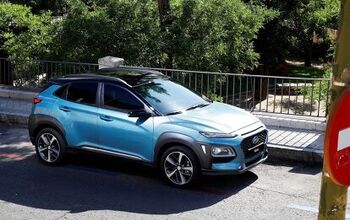Hyundai's Subcompact Crossover Has a Name: 'Kona'

After its skyrocketing post-recessions sales hit a roadblock in the United States, Hyundai can’t wait to sell Americans more crossovers. It just needs to build them first.
While the Korean automaker already has plans to tinker around with its existing utility lineup, it lacks product on the small end of the scale, which currently gives rivals an edge.
Well, not for long.
Today, Hyundai revealed the name that will soon join the subcompact CUV fray — Kona. Overseas markets will see the Kona in the second half of this year, but those all-important U.S. buyers will have to wait just a little while longer.
If you’re familiar with Hawaii, you’ll know the Kona name isn’t derived from anything Korean. A district on the west coast of the Big Island, Kona sounds like paradise to anyone who has to suffer through windshield scraping and block heater repair. It also sounds very global, key for a mass-market model.
Hyundai furnished us with a teaser image, but there’s not much else to go on besides Hyundai’s claim that the Kona will arrive with “bold, striking design and high interior refinement and spaciousness” — something we’ve heard about every product from every automaker. You’re guaranteed narrow LED headlights, folks.
Contrary to early reports, there won’t be a Kona at the New York Auto Show. According to Derek Joyce, Hyundai Motor America’s product public relations manager, the automaker plans to use the venue to get buyers interested in the refreshed 2018 Sonata.
“At this time, we can only confirm the Kona name and that it will compete with other B-segment CUVs, broadening Hyundai’s impressive CUV line-up,” said Joyce. “Kona will launch in the Korean domestic market in the summer of 2017 and in the U.S. market in early 2018.”
Product details should be available in the near future, he told TTAC.
With Ford targeting the U.S. with its overseas-market EcoSport and Toyota entering the B-segment game with its C-HR, Hyundai needs a product to rebuff those models, as well as Mazda’s CX-3 and Honda’s H-RV. An A-segment CUV could follow the Kona, but that market isn’t nearly as important. Meanwhile, Hyundai plans to grow the Tucson and Santa Fe Sport slightly, with the range-topping Santa Fe due for eight-passenger capacity and a name change.
[Image: Hyundai Motors]

More by Steph Willems
Latest Car Reviews
Read moreLatest Product Reviews
Read moreRecent Comments
- SPPPP I suppose I am afraid of autonomous cars in a certain sense. I prefer to drive myself when I go places. If I ride as a passenger in another driver's car, I can see if that person looks alert and fit for purpose. If that person seems likely to crash, I can intervene, and attempt to bring them back to attention. If there is no human driver, there will probably be no warning signs of an impending crash.But this is less significant than the over-arching fear of humans using autonomous driving as a tool to disempower and devalue other humans. As each generation "can't be trusted" with more and more things, we seem to be turning more passive and infantile. I fear that it will weaken our society and make it more prone to exploitation from within, and/or conquest from the outside.
- JMII Based on the human drivers I encounter everyday I'll happily take my chances with a computer at the wheel.The highway driver assist system on my Santa Cruz is great, it can self drive perfectly in about 90% of situations. However that other 10% requires you to be in control and make decisions. I feel this is the problem with an AI driving a car, there are times when due to road construction, weather conditions or other drivers when only a human will know what to do.
- Hari Your route home sounds like the perfect stretch for a car like the Alfa Romeo Giulia. Its renowned handling and dynamic performance make it an ideal match for those curves. For enthusiasts or potential owners interested in understanding all the capabilities of the Giulia 2017, the owner’s manual is an invaluable resource. Check it out here: https://chatwithmanuals.com/automobiles/2017-alfa-romeo-giulia-owners-manual/. Our AI-powered chat makes navigating the manual simple, helping you quickly find specific details about the car's features and specs. Perfect for making the most out of those driving moments and truly understanding your vehicle!
- Dale I'd consider the RAV4 if the Prime were on the table as paying for gas is for suckers. Otherwise, we have a couple of Mazdas and they are swell. I've driven older versions of both and the CX-5 is a nicer place to live.
- Haran Spot-on review of the Mercedes-AMG GT’s price adjustments and new features! For those intrigued by the all-wheel drive and enhanced features of the latest model, you can delve deeper with the complete operator's manual available here: https://chatwithmanuals.com/automobiles/mercedes-amg-gt-operators-manual-edition-c2020/. It’s a fantastic resource for understanding all the specs and new additions without getting bogged down by the complexity typically associated with car manuals. Chat with the manual using AI to quickly find exactly what you need to know about this sporty beast. Perfect for those who appreciate detailed insights on their luxury investments!


































Comments
Join the conversation
Kona bicycles is still in business - did Hyundai have to pay them anything to use the name? Or is it a non-issue, since these are cars? Also, remember the Kona Edition Focus, that came with a bike rack, and a Kona bike? I still see one of those occasionally.
Guess Ford has to change the name of their dark blue paint...